+ データを開く
データを開く
- 基本情報
基本情報
| 登録情報 |  | |||||||||
|---|---|---|---|---|---|---|---|---|---|---|
| タイトル | Cryo-EM structure of ETBR bound with BQ3020 | |||||||||
 マップデータ マップデータ | ||||||||||
 試料 試料 |
| |||||||||
 キーワード キーワード | GPCR / COMPLEX / ETB / BQ3020 / SIGNALING PROTEIN | |||||||||
| 機能・相同性 |  機能・相同性情報 機能・相同性情報enteric smooth muscle cell differentiation / response to endothelin / negative regulation of neuron maturation / neuroblast migration / chordate pharynx development / endothelin receptor activity / aldosterone metabolic process / regulation of fever generation / vein smooth muscle contraction / positive regulation of penile erection ...enteric smooth muscle cell differentiation / response to endothelin / negative regulation of neuron maturation / neuroblast migration / chordate pharynx development / endothelin receptor activity / aldosterone metabolic process / regulation of fever generation / vein smooth muscle contraction / positive regulation of penile erection / heparin proteoglycan metabolic process / posterior midgut development / epithelial fluid transport / endothelin receptor signaling pathway / podocyte differentiation / developmental pigmentation / response to sodium phosphate / renal sodium excretion / renal sodium ion absorption / enteric nervous system development / protein transmembrane transport / renin secretion into blood stream / renal albumin absorption / melanocyte differentiation / vasoconstriction / regulation of pH / peripheral nervous system development / type 1 angiotensin receptor binding / negative regulation of adenylate cyclase activity / positive regulation of urine volume / ganglioside catabolic process / regulation of epithelial cell proliferation / establishment of endothelial barrier / oligosaccharide catabolic process / neural crest cell migration / negative regulation of protein metabolic process / cGMP-mediated signaling / response to pain / exo-alpha-sialidase / macrophage chemotaxis / exo-alpha-sialidase activity / peptide hormone binding / canonical Wnt signaling pathway / Transcriptional and post-translational regulation of MITF-M expression and activity / regulation of heart rate / Peptide ligand-binding receptors / calcium-mediated signaling / calcium ion transmembrane transport / Olfactory Signaling Pathway / Activation of the phototransduction cascade / G beta:gamma signalling through PLC beta / Presynaptic function of Kainate receptors / Thromboxane signalling through TP receptor / G protein-coupled acetylcholine receptor signaling pathway / G-protein activation / Activation of G protein gated Potassium channels / Inhibition of voltage gated Ca2+ channels via Gbeta/gamma subunits / Prostacyclin signalling through prostacyclin receptor / G beta:gamma signalling through CDC42 / Glucagon signaling in metabolic regulation / G beta:gamma signalling through BTK / Synthesis, secretion, and inactivation of Glucagon-like Peptide-1 (GLP-1) / ADP signalling through P2Y purinoceptor 12 / Sensory perception of sweet, bitter, and umami (glutamate) taste / photoreceptor disc membrane / Glucagon-type ligand receptors / Adrenaline,noradrenaline inhibits insulin secretion / Vasopressin regulates renal water homeostasis via Aquaporins / G alpha (z) signalling events / Glucagon-like Peptide-1 (GLP1) regulates insulin secretion / cellular response to catecholamine stimulus / ADP signalling through P2Y purinoceptor 1 / ADORA2B mediated anti-inflammatory cytokines production / vasodilation / G beta:gamma signalling through PI3Kgamma / Cooperation of PDCL (PhLP1) and TRiC/CCT in G-protein beta folding / adenylate cyclase-activating dopamine receptor signaling pathway / GPER1 signaling / Inactivation, recovery and regulation of the phototransduction cascade / cellular response to prostaglandin E stimulus / G-protein beta-subunit binding / heterotrimeric G-protein complex / nervous system development / G alpha (12/13) signalling events / sensory perception of taste / extracellular vesicle / signaling receptor complex adaptor activity / Thrombin signalling through proteinase activated receptors (PARs) / retina development in camera-type eye / positive regulation of cytosolic calcium ion concentration / cellular response to lipopolysaccharide / GTPase binding / Ca2+ pathway / fibroblast proliferation / High laminar flow shear stress activates signaling by PIEZO1 and PECAM1:CDH5:KDR in endothelial cells / G alpha (i) signalling events / G alpha (s) signalling events / phospholipase C-activating G protein-coupled receptor signaling pathway / nuclear membrane / G alpha (q) signalling events 類似検索 - 分子機能 | |||||||||
| 生物種 |  Homo sapiens (ヒト) / Homo sapiens (ヒト) /  | |||||||||
| 手法 | 単粒子再構成法 / クライオ電子顕微鏡法 / 解像度: 3.0 Å | |||||||||
 データ登録者 データ登録者 | Hou JY / Liu SH / Wu LJ / Liu ZJ / Hua T | |||||||||
| 資金援助 | 1件
| |||||||||
 引用 引用 |  ジャーナル: Cell Discov / 年: 2024 ジャーナル: Cell Discov / 年: 2024タイトル: Structural basis of antagonist selectivity in endothelin receptors. 著者: Junyi Hou / Shenhui Liu / Xiaodan Zhang / Guowei Tu / Lijie Wu / Yijie Zhang / Hao Yang / Xiangcheng Li / Junlin Liu / Longquan Jiang / Qiwen Tan / Fang Bai / Zhijie Liu / Changhong Miao / Tian Hua / Zhe Luo /  要旨: Endothelins and their receptors, ET and ET, play vital roles in maintaining vascular homeostasis. Therapeutically targeting endothelin receptors, particularly through ET antagonists, has shown ...Endothelins and their receptors, ET and ET, play vital roles in maintaining vascular homeostasis. Therapeutically targeting endothelin receptors, particularly through ET antagonists, has shown efficacy in treating pulmonary arterial hypertension (PAH) and other cardiovascular- and renal-related diseases. Here we present cryo-electron microscopy structures of ET in complex with two PAH drugs, macitentan and ambrisentan, along with zibotentan, a selective ET antagonist, respectively. Notably, a specialized anti-ET antibody facilitated the structural elucidation. These structures, together with the active-state structures of ET-1-bound ET and ET, and the agonist BQ3020-bound ET, in complex with G, unveil the molecular basis of agonist/antagonist binding modes in endothelin receptors. Key residues that confer antagonist selectivity to endothelin receptors were identified along with the activation mechanism of ET. Furthermore, our results suggest that ECL2 in ET can serve as an epitope for antibody-mediated receptor antagonism. Collectively, these insights establish a robust theoretical framework for the rational design of small-molecule drugs and antibodies with selective activity against endothelin receptors. | |||||||||
| 履歴 |
|
- 構造の表示
構造の表示
| 添付画像 |
|---|
- ダウンロードとリンク
ダウンロードとリンク
-EMDBアーカイブ
| マップデータ |  emd_38702.map.gz emd_38702.map.gz | 56.8 MB |  EMDBマップデータ形式 EMDBマップデータ形式 | |
|---|---|---|---|---|
| ヘッダ (付随情報) |  emd-38702-v30.xml emd-38702-v30.xml emd-38702.xml emd-38702.xml | 22.4 KB 22.4 KB | 表示 表示 |  EMDBヘッダ EMDBヘッダ |
| FSC (解像度算出) |  emd_38702_fsc.xml emd_38702_fsc.xml | 8.4 KB | 表示 |  FSCデータファイル FSCデータファイル |
| 画像 |  emd_38702.png emd_38702.png | 47.4 KB | ||
| Filedesc metadata |  emd-38702.cif.gz emd-38702.cif.gz | 7.1 KB | ||
| その他 |  emd_38702_half_map_1.map.gz emd_38702_half_map_1.map.gz emd_38702_half_map_2.map.gz emd_38702_half_map_2.map.gz | 59.4 MB 59.4 MB | ||
| アーカイブディレクトリ |  http://ftp.pdbj.org/pub/emdb/structures/EMD-38702 http://ftp.pdbj.org/pub/emdb/structures/EMD-38702 ftp://ftp.pdbj.org/pub/emdb/structures/EMD-38702 ftp://ftp.pdbj.org/pub/emdb/structures/EMD-38702 | HTTPS FTP |
-検証レポート
| 文書・要旨 |  emd_38702_validation.pdf.gz emd_38702_validation.pdf.gz | 769.6 KB | 表示 |  EMDB検証レポート EMDB検証レポート |
|---|---|---|---|---|
| 文書・詳細版 |  emd_38702_full_validation.pdf.gz emd_38702_full_validation.pdf.gz | 769.1 KB | 表示 | |
| XML形式データ |  emd_38702_validation.xml.gz emd_38702_validation.xml.gz | 16 KB | 表示 | |
| CIF形式データ |  emd_38702_validation.cif.gz emd_38702_validation.cif.gz | 20.5 KB | 表示 | |
| アーカイブディレクトリ |  https://ftp.pdbj.org/pub/emdb/validation_reports/EMD-38702 https://ftp.pdbj.org/pub/emdb/validation_reports/EMD-38702 ftp://ftp.pdbj.org/pub/emdb/validation_reports/EMD-38702 ftp://ftp.pdbj.org/pub/emdb/validation_reports/EMD-38702 | HTTPS FTP |
-関連構造データ
- リンク
リンク
| EMDBのページ |  EMDB (EBI/PDBe) / EMDB (EBI/PDBe) /  EMDataResource EMDataResource |
|---|---|
| 「今月の分子」の関連する項目 |
- マップ
マップ
| ファイル |  ダウンロード / ファイル: emd_38702.map.gz / 形式: CCP4 / 大きさ: 64 MB / タイプ: IMAGE STORED AS FLOATING POINT NUMBER (4 BYTES) ダウンロード / ファイル: emd_38702.map.gz / 形式: CCP4 / 大きさ: 64 MB / タイプ: IMAGE STORED AS FLOATING POINT NUMBER (4 BYTES) | ||||||||||||||||||||||||||||||||||||
|---|---|---|---|---|---|---|---|---|---|---|---|---|---|---|---|---|---|---|---|---|---|---|---|---|---|---|---|---|---|---|---|---|---|---|---|---|---|
| 投影像・断面図 | 画像のコントロール
画像は Spider により作成 | ||||||||||||||||||||||||||||||||||||
| ボクセルのサイズ | X=Y=Z: 1.04 Å | ||||||||||||||||||||||||||||||||||||
| 密度 |
| ||||||||||||||||||||||||||||||||||||
| 対称性 | 空間群: 1 | ||||||||||||||||||||||||||||||||||||
| 詳細 | EMDB XML:
|
-添付データ
- 試料の構成要素
試料の構成要素
-全体 : Complex of protein Gsq with ETB and BQ3020
| 全体 | 名称: Complex of protein Gsq with ETB and BQ3020 |
|---|---|
| 要素 |
|
-超分子 #1: Complex of protein Gsq with ETB and BQ3020
| 超分子 | 名称: Complex of protein Gsq with ETB and BQ3020 / タイプ: complex / ID: 1 / 親要素: 0 / 含まれる分子: all |
|---|---|
| 由来(天然) | 生物種:  Homo sapiens (ヒト) Homo sapiens (ヒト) |
-分子 #1: Isoform Gnas-2 of Guanine nucleotide-binding protein G(s) subunit...
| 分子 | 名称: Isoform Gnas-2 of Guanine nucleotide-binding protein G(s) subunit alpha isoforms short タイプ: protein_or_peptide / ID: 1 / コピー数: 1 / 光学異性体: LEVO |
|---|---|
| 由来(天然) | 生物種:  Homo sapiens (ヒト) Homo sapiens (ヒト) |
| 分子量 | 理論値: 30.464314 KDa |
| 組換発現 | 生物種:  |
| 配列 | 文字列: HHHHHHENLY FQGNSKTEDQ RNEEKAQREA NKKIEKQLQK DKQVYRATHR LLLLGADNSG KSTIVKQMRI LHGGSGGSGG TSGIFETKF QVDKVNFHMF DVGGQRDERR KWIQCFNDVT AIIFVVDSSD YNRLQEALNL FKSIWNNRWL RTISVILFLN K QDLLAEKV ...文字列: HHHHHHENLY FQGNSKTEDQ RNEEKAQREA NKKIEKQLQK DKQVYRATHR LLLLGADNSG KSTIVKQMRI LHGGSGGSGG TSGIFETKF QVDKVNFHMF DVGGQRDERR KWIQCFNDVT AIIFVVDSSD YNRLQEALNL FKSIWNNRWL RTISVILFLN K QDLLAEKV LAGKSKIEDY FPEFARYTTP EDATPEPGED PRVTRAKYFI RDEFLRISTA SGDGRHYCYP HFTCAVDTEN AR RIFNDCK DIILQMNLRE YNLV |
-分子 #2: Guanine nucleotide-binding protein G(I)/G(S)/G(T) subunit beta-1
| 分子 | 名称: Guanine nucleotide-binding protein G(I)/G(S)/G(T) subunit beta-1 タイプ: protein_or_peptide / ID: 2 / コピー数: 1 / 光学異性体: LEVO |
|---|---|
| 由来(天然) | 生物種:  Homo sapiens (ヒト) Homo sapiens (ヒト) |
| 分子量 | 理論値: 38.045629 KDa |
| 組換発現 | 生物種:  |
| 配列 | 文字列: IGRARGFSEL DQLRQEAEQL KNQIRDARKA CADATLSQIT NNIDPVGRIQ MRTRRTLRGH LAKIYAMHWG TDSRLLVSAS QDGKLIIWD SYTTNKVHAI PLRSSWVMTC AYAPSGNYVA CGGLDNICSI YNLKTREGNV RVSRELAGHT GYLSCCRFLD D NQIVTSSG ...文字列: IGRARGFSEL DQLRQEAEQL KNQIRDARKA CADATLSQIT NNIDPVGRIQ MRTRRTLRGH LAKIYAMHWG TDSRLLVSAS QDGKLIIWD SYTTNKVHAI PLRSSWVMTC AYAPSGNYVA CGGLDNICSI YNLKTREGNV RVSRELAGHT GYLSCCRFLD D NQIVTSSG DTTCALWDIE TGQQTTTFTG HTGDVMSLSL APDTRLFVSG ACDASAKLWD VREGMCRQTF TGHESDINAI CF FPNGNAF ATGSDDATCR LFDLRADQEL MTYSHDNIIC GITSVSFSKS GRLLLAGYDD FNCNVWDALK ADRAGVLAGH DNR VSCLGV TDDGMAVATG SWDSFLKIWN UniProtKB: Guanine nucleotide-binding protein G(I)/G(S)/G(T) subunit beta-1 |
-分子 #3: Guanine nucleotide-binding protein G(I)/G(S)/G(O) subunit gamma-2
| 分子 | 名称: Guanine nucleotide-binding protein G(I)/G(S)/G(O) subunit gamma-2 タイプ: protein_or_peptide / ID: 3 / コピー数: 1 / 光学異性体: LEVO |
|---|---|
| 由来(天然) | 生物種:  Homo sapiens (ヒト) Homo sapiens (ヒト) |
| 分子量 | 理論値: 7.861143 KDa |
| 組換発現 | 生物種:  |
| 配列 | 文字列: MASNNTASIA QARKLVEQLK MEANIDRIKV SKAAADLMAY CEAHAKEDPL LTPVPASENP FREKKFFCAI L UniProtKB: Guanine nucleotide-binding protein G(I)/G(S)/G(O) subunit gamma-2 |
-分子 #4: Nanobody 35
| 分子 | 名称: Nanobody 35 / タイプ: protein_or_peptide / ID: 4 / コピー数: 1 / 光学異性体: LEVO |
|---|---|
| 由来(天然) | 生物種:  |
| 分子量 | 理論値: 17.057271 KDa |
| 組換発現 | 生物種:  |
| 配列 | 文字列: MKYLLPTAAA GLLLLAAQPA MAMQVQLQES GGGLVQPGGS LRLSCAASGF TFSNYKMNWV RQAPGKGLEW VSDISQSGAS ISYTGSVKG RFTISRDNAK NTLYLQMNSL KPEDTAVYYC ARCPAPFTRD CFDVTSTTYA YRGQGTQVTV SSHHHHHH |
-分子 #5: BQ3020
| 分子 | 名称: BQ3020 / タイプ: protein_or_peptide / ID: 5 / コピー数: 1 / 光学異性体: LEVO |
|---|---|
| 由来(天然) | 生物種:  Homo sapiens (ヒト) Homo sapiens (ヒト) |
| 分子量 | 理論値: 1.966302 KDa |
| 組換発現 | 生物種:  Homo sapiens (ヒト) Homo sapiens (ヒト) |
| 配列 | 文字列: LMDKEAVYFA HLDIIW |
-分子 #6: Exo-alpha-sialidase,Endothelin receptor type B
| 分子 | 名称: Exo-alpha-sialidase,Endothelin receptor type B / タイプ: protein_or_peptide / ID: 6 / コピー数: 1 / 光学異性体: LEVO / EC番号: exo-alpha-sialidase |
|---|---|
| 由来(天然) | 生物種:  Homo sapiens (ヒト) Homo sapiens (ヒト) |
| 分子量 | 理論値: 94.123805 KDa |
| 組換発現 | 生物種:  |
| 配列 | 文字列: MKTIIALSYI FCLVFADYKD DDDAGRAVEG AVKTEPVDLF HPGFLNSSNY RIPALFKTKE GTLIASIDAR RHGGADAPNN DIDTAVRRS EDGGKTWDEG QIIMDYPDKS SVIDTTLIQD DETGRIFLLV THFPSKYGFW NAGLGSGFKN IDGKEYLCLY D SSGKEFTV ...文字列: MKTIIALSYI FCLVFADYKD DDDAGRAVEG AVKTEPVDLF HPGFLNSSNY RIPALFKTKE GTLIASIDAR RHGGADAPNN DIDTAVRRS EDGGKTWDEG QIIMDYPDKS SVIDTTLIQD DETGRIFLLV THFPSKYGFW NAGLGSGFKN IDGKEYLCLY D SSGKEFTV RENVVYDKDS NKTEYTTNAL GDLFKNGTKI DNINSSTAPL KAKGTSYINL VYSDDDGKTW SEPQNINFQV KK DWMKFLG IAPGRGIQIK NGEHKGRIVV PVYYTNEKGK QSSAVIYSDD SGKNWTIGES PNDNRKLENG KIINSKTLSD DAP QLTECQ VVEMPNGQLK LFMRNLSGYL NIATSFDGGA TWDETVEKDT NVLEPYCQLS VINYSQKVDG KDAVIFSNPN ARSR SNGTV RIGLINQVGT YENGEPKYEF DWKYNKLVKP GYYAYSCLTE LSNGNIGLLY EGTPSEEMSY IEMNLKYLES GANKA PAEV PKGDRTAGSP PRTISPPPCQ GPIEIKETFK YINTVVSCLV FVLGIIGNST LLRIIYKNKC MRNGPNILIA SLALGD LLH IVIDIPINVY KLLAEDWPFG AEMCKLVPFI QKASVGITVL SLCALSIDRY RAVASWSRIK GIGVPKWTAV EIVLIWV VS VVLAVPEAIG FDIITMDYKG SYLRICLLHP VQKTAFMQFY KTAKDWWLFS FYFCLPLAIT AFFYTLMTCE MLRKKSGM Q IALNDHLKQR REVAKTVFCL VLVFALCWLP LHLSRILKLT LYNQNDPNRC ELLSFLLVLD YIGINMASLN SCINPIALY LVSKRFKNCF KSCLCCWCQL EVLFQGPHHH HHHHHHH UniProtKB: exo-alpha-sialidase, Endothelin receptor type B |
-実験情報
-構造解析
| 手法 | クライオ電子顕微鏡法 |
|---|---|
 解析 解析 | 単粒子再構成法 |
| 試料の集合状態 | particle |
- 試料調製
試料調製
| 緩衝液 | pH: 7.4 |
|---|---|
| 凍結 | 凍結剤: ETHANE |
- 電子顕微鏡法
電子顕微鏡法
| 顕微鏡 | FEI TITAN KRIOS |
|---|---|
| 撮影 | フィルム・検出器のモデル: FEI FALCON IV (4k x 4k) 平均電子線量: 60.0 e/Å2 |
| 電子線 | 加速電圧: 300 kV / 電子線源:  FIELD EMISSION GUN FIELD EMISSION GUN |
| 電子光学系 | 照射モード: FLOOD BEAM / 撮影モード: BRIGHT FIELD / 最大 デフォーカス(公称値): 2.0 µm / 最小 デフォーカス(公称値): 1.0 µm |
| 実験機器 |  モデル: Titan Krios / 画像提供: FEI Company |
 ムービー
ムービー コントローラー
コントローラー




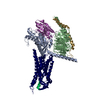





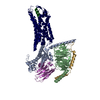


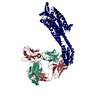
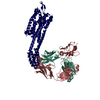
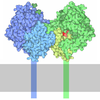


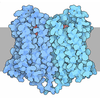
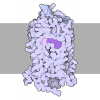








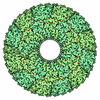





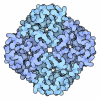
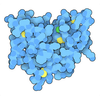




 Z (Sec.)
Z (Sec.) Y (Row.)
Y (Row.) X (Col.)
X (Col.)





















